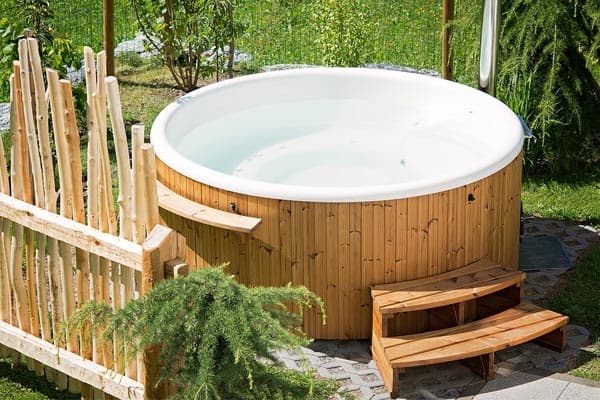Baking Soda Can Safely Increase Your Hot Tub’s Alkalinity Levels
Keeping your alkalinity levels correct in your hot tub is critical for ensuring that your equipment works at peak levels while extending the equipment’s lifespan.
Most people use harsh chemicals in dry or liquid form to lower the alkalinity in your hot tub to acceptable levels, and these chemicals can damage the hot tub, cause skin irritation or burns, and damage the area where you store them.
So, how do you increase the alkalinity level in your hot tub?
To raise the alkalinity levels in the water, you’ll add one tablespoon of baking soda per every hundred gallons of water in your hot tub. If you have a hot tub that holds 500 gallons of water, you’ll add five tablespoons to raise your alkalinity.
After you add it, allow it to circulate for an hour before testing it and adjusting it as necessary. However, there’s more to know about alkalinity, baking, soda, and how to work in your hot tub.
We’re going to explore how pH and alkalinity work together in this post to ensure you get the correct levels and understand why they’re so important.
We’ll also outline how you raise your total alkalinity in steps that are easy to follow, so you get a healthy environment to relax in.
Why Baking Soda Increases the Alkalinity in Your Hot Tub
Baking soda can work to raise both the alkalinity and pH levels in your hot tub when you add it, but it works better to raise the alkalinity over pH.
Your pH levels should stay between 7.2 and 7.8 at all times, and pH levels that are higher mean that your water is too alkaline.
If the water is too alkaline, it can cause your hot tub’s components like the heating system to get damaged. Baking soda can work to raise the alkalinity levels in the water.
Understanding Total Alkalinity
In a hot tub, the pH is responsible for measuring the acidity levels in the hot tub water. The alkalinity is the component that measures how well your waterworks neutralize the acid content. So, both items may interact with one another, but they’re very different.
How Much Baking Soda You Need to Raise the Water’s Alkalinity
Add a single tablespoon of baking soda per 100 gallons of water in your hot tub to raise the alkalinity level. So, if your hot tub is smaller and holds 250 gallons, you’ll need two-and-a-half tablespoons of baking soda.
You’ll do the following when you raise your alkalinity:
- Take a look at the manual that came with your hot tub to figure out exactly how many gallons of water it holds. You may have to reach out to the manufacturer if you don’t have a manual.
- Switch the jets off in your hot tub and use a test strip to see your current pH levels.
- Add the amount of baking soda you need and switch your jets back on. The jets will work to circulate the baking soda and mix it evenly into the water. Run the jets for two to four hours before moving to the next step.
- Get a test strip and test the hot tub’s pH levels after two or four hours to ensure they’re inside safe levels. Test the alkalinity levels at the same time to make sure it’s in the correct range between 80 and 100 parts per million.
Does Baking Soda Raise the pH Levels?
Baking soda will raise your hot tub’s pH and alkalinity levels, but it has a much greater impact on the alkalinity level.
The first step is to get a test strip and test the pH levels in the water by getting a water sample and dipping a test strip into it before comparing it to the chart.
If you need to adjust the pH levels, so they’re between 7.2 and 7.8, all you have to do is sprinkle one ounce of baking soda into the water and allow it to circulate for 20 minutes.
Get your test strips and retest the pH levels and continue adjusting as necessary until you reach the correct parameters.
Consequences of High Total Alkalinity
Higher alkalinity levels won’t damage your hot tub as much as low levels of alkalinity will; it’s still important to keep it balanced to prolong your hot tub’s life and reduce the amount of maintenance you have to do.
One of the biggest problems with high alkalinity is murky or cloudy water because your hot tub water lets particles come out of the solution and float freely in the water.
This water dissolution can lead to other hot tub issues when your alkalinity levels are too high, including:
- Scale buildup on hot tub equipment or surfaces
- Filters that clog very quickly
- Water circulation reduces because the filters and pipes start to clog due to free-floating particles in the water. The particles end up deposited on anything the hot tub water comes into contact with, like the pipes, pumps, and shell.
- Higher water pressure because the pipes narrow with scale, and the pumps get clogged. The system has to run harder to push water through, and this can lead to cracks.
- pH lock where it gets harder to change your water’s pH levels due to the higher alkalinity in the hot tub
How to Safely Lower Your Hot Tub’s Alkalinity Levels
If you want to lower the total alkalinity in your hot tub, you could turn to chemical solutions, and the two most popular options are sodium bisulfate or dry acid, and muriatic acid.
You’ll add the muriatic acid, another dry acid, or sodium bisulfate to the water first. Give these products two to four hours to work before testing the water, and be sure to test the pH levels too because these products can cause it to fall.
Issues with Low Alkalinity Readings
You know that low calcium hardness and low pH levels can damage your hot tub, but so can having lower total alkalinity levels.
You might not notice that your hot tub has lower alkalinity levels at first when you look at your hot tub surface or equipment, but lower alkalinity can cause the pH levels to drop.
This will turn the hot tub water more acidic, and you can end up with irritated eyes or itchy skin if you expose yourself to it. There are other problems associated with having low alkalinity in the hot tub, including:
- pH bounce where the pH levels fluctuate quickly
- Etching, pitting, delaminating, or cracking of the hot tub surface or walls
- Hot tub sanitizing chemicals are less effective, so you’ll need to add much more to get the same impact
- Metal surfaces corrode in and around the hot tub, including on the pump seals, heating elements, pipes, heaters, and other internal parts
- Staining on your hot tub walls
Bottom Line
You can use baking soda to raise the alkalinity levels in your hot tub water to make it safer for both the occupants and the hot tub itself.
The goal is to monitor both your pH and alkalinity levels to ensure they stay within the correct parameters to extend the life of your hot tub and ensure it’s ready to go whenever you are






